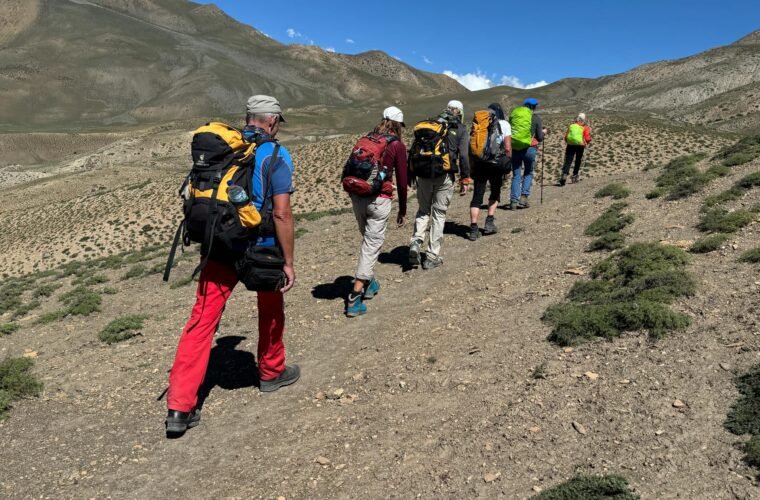-Rejan Meher Bajracharya
Nepal is recognized worldwide for its natural beauty alongside its rich culture, hospitable people, and extraordinary history. After the post-pandemic period when everything started getting back to normal, a surge in the tourism industry raised conversations about sustainable tourism. However, considering the current context, one of the most neglected areas is tourism insurance and risk management, which have so much to offer in terms of making tourism more sustainable.
Equally important, to enhance the tourism industry in Nepal, these strategically crafted financial tools are vital as they foster balanced travel and development while shielding the industry from environmental, economic and operational shocks.
There are a variety of activities that visitors can take part while in Nepal, giving them some of the best experiences in the world. With all the opportunities that come along, there are also certain threats that one must keep in mind. The country is probe to natural disasters like floods, landslides, earthquakes, and avalanches which can make travel devastating.
To enhance the safety of tourists, some measures such as insurance schemes have been introduced. These include travel insurance which protects a person’s health and adventure protection coverage, as well as business interruption coverage. This type of insurance safeguards travelers from incurring expenses if certain unforeseen circumstances impede their travel plans, both domestically and internationally.
Adventure travel insurance encompasses trip postponements, medical treatment, and the misplacement of personal belongings. Business interruption protects revenues generated by the firm from being lost during severe unexpected events like fire or flooding. During the company’s operational pause, business interruption insurance subsidizes the revenue lost, aiding the affected firm.
Having appropriate insurance offers relevant value for both the tourists and tourism service providers in Nepal. For travelers, it offers financial support in the event of unanticipated injuries, lost belongings, or trip cancellations. It will strengthen their perception of Nepal as a secure and trustful destination.
For local businesses such as tour operators and guides, insurance is a form of protection that allows them to offset losses incurred from accidents, natural calamities, or even emergent clients. These provisions ensure the smooth running of business alongside the much-needed investment in the tourism industry.
However, the provisions still have quite a few shortcomings. The lack of adequate tourist facilities in rural or remote areas makes many insurance options unavailable which makes accessible coverage impossible. Issues such as insurance fraud, poor governance, and inadequate openness weaken the already meager faith in the system. Furthermore, the absence of well-defined universal policies and regulations around tourism insurance in Nepal creates inconsistency, bias, and ineffective risk control in the industry.
For sustainable tourism, risk management strategies should be put into place. It could be determining and mitigating risks associated with tourism, its impacts on the environment and local communities in the long run. It involves examining the impacts which these activities can pose to the environment, managing excessive visitors, and adopting environmentally friendly measures. It also entails collaborating with local people to safeguard and promote cultural identity, economic sustainability, and proactive planning for emergencies like natural calamities or pandemics. Adapting to climate change also helps keep tourist areas strong. All in all, these approaches aim at striking a balance between economic growth and environmental conservation through responsible tourism.
The 2023 Yeti Airlines incident and the subsequent disaster emphasized the necessity for more comprehensive tourism insurance coverage concerning air travel in Nepal. For example, trekking companies in Nepal require trekkers for insurance coverage concerning rescue and evacuation. In Community Based Tourism initiatives, residents often manage the risks collectively by forming insurance pools to deal with situations pertaining to economic or environmental damage. These steps continue to demonstrate that there is a need to safeguard both the traveler and the residents while encouraging sustainable tourism.
Financial instruments and new ideas remain unmatched in promoting tourism, especially in rural areas. Micro-insurance is one of them since it empowers small businesses to recover economically devastating events like natural disasters at little to no loss. Businesses suffering from a crisis can regain stability quickly through disaster relief funds from the private or public sector. In addition, many new mobile technologies and digital platforms are improving access to affordable insurance for small businesses based in remote areas. These instruments strengthen the economy, but they also open new opportunities for growth and investment. These innovations make it easier for insurers to provide coverage during challenging periods, thus supporting rural tourism, which enhances its longevity.
Other than the use of advanced strategies, the effectiveness of risk management in tourism can be improved with some basic adjustments. For example, raising public awareness of tourism insurance will help businesses and the public appreciate its value. Moreover, compulsory insurance for certain high- risk activities, such as trekking and adventure sports will improve coverage. Collaboration among sectors also enhances the management of tourism risk. Invest in resources for the development of technologies capable of providing timely warnings and rapid response to disasters. These steps will minimize the damage suffered. Finally, the swift adoption of preemptive policies regarding national and regional declarations will aid tourism businesses to recover more swiftly after a disaster.
In conclusion, the sustainable tourism model in Nepal looks at creating opportunities for both the tourists and locals to participate productively while simultaneously mitigating risks. Carving a strategy requires collaboration from all government branches, the business community, and the locals who must employ adequate cover and risk management frameworks for sustainability of the sector. Adequate controls and policy instruments are available which can allow Nepal to become a dominantly positioned fostered sustainable tourism protected area, garrisoning the environment while stimulating economic growth. What needs to be done now is to increase the stability and enhance the impact and operational efficiency of the tourism industry.
(Bajracharya is a master’s degree graduate in management from Mega National College, Kathmandu)





